Reading the Signs on the Wall:
Unsanctioned Images in the Public Sphere
Part I
Dr. Marshall Soules, Vancouver Island University
March 10, 2005
Visual Culture Conference
Kansas State University, Manhattan, Kansas
In jurisdictions around the world, graffiti and unsanctioned postering have been identified as a costly urban social problem. In 2003, it was estimated that graffiti cost the city of London, UK £100 M in cleanup, prevention, and lost revenue. Montreal spends $3 M annually cleaning up graffiti and “wild postering” (affichage sauvage) on public and private property, and another $5 M in subway stations alone. While many solutions have been proposed, most of the relevant legislation treats graffiti as vandalism and postering as a form of unsightliness or litter; recent legislation in the United Kingdom allocates £95 M to the implementation of a broad range of strategies to curb “anti-social behavior” including graffiti, littering, and selling cans of spray paint to minors.
These related cultural productions are assumed to signify urban decay and increased incidence of crime, and municipalities are often willing to devote considerable resources to control them. Besides the costs, attempts to control unsanctioned images usually have legal implications related to municipal jurisdiction and freedom of expression guarantees. In Canada, the Charter of Rights and Freedoms was invoked in the significant Supreme Court case of Ramsden vs. Peterborough (city) to guarantee the rights of citizens to use posters as a means of public expression. An outright ban on all postering was considered to abridge freedom of expression.
Against the prohibitions of legislation, many argue that unsanctioned images have artistic merit and provide insight into social and political issues. There is extensive literature on the style and motivations of graffiti artists; on the virtues of street art; and the importance of postering as an accessible and relatively affordable medium of communication. Our contemporary understanding of these phenomena—and our resistance to them—depends as well on the long history of mural painting and political graffiti. At least since Martin Luther, history has illustrated the power of the manifesto, the poster, and the slogan to animate the citizenry and initiate action. Against this long tradition of social activism and dialogue between the classes, the justification for banning postering as unsightly litter can only appear trivial and disingenuous. We argue here that municipalities should chose the language of their legislation carefully if they hope to avoid unintended consequences.
* * *
She led me into the shadows that waited beyond the bright tube
platform.
The concrete walls were overlaid with graffiti, years of them twisting
into a single metascrawl of rage and frustration. (William Gibson, “Johnny
Mnemonic”)
Our research investigates the phenomenon of urban graffiti (inscriptions, drawings or messages traced on walls, monuments, engineering works, and urban furniture), tagging (signatures indicating a delimitation of territory for a person or group), and “wild” postering (unauthorized posting of publicity material or personal messages on urban furniture or the walls of the public or private domain). Our research to date has mainly been in the context of Canadian municipalities, but with significant and detailed comparisons to international jurisdictions and examples. We are particularly interested to distinguish between sanctioned and unsanctioned (or criminalized) activities related to urban signs, and the legislative language used to establish this distinction.
To explore this subject, we pose a number of questions:
- What ideologies compete for control of space for signs in the urban environment? How does a distinction between “official” and “unofficial” images bear weight in this analysis?
- What assumptions are embedded in legislation and policies which criminalize graffiti and limit visual space for postering and other similar expressions? What motivates bureaucracies to regulate the visual aesthetic of cities?
- What are these expressions of culture telling us about the urban world? And what is lost by the campaign against them?
Our research is situated at the intersection of legal, cultural, and social issues related to graffiti and postering. We hope to provide insights into graffiti and postering as visual phenomena revealing issues of class, perceptions of criminality, degrees of legislative control and orderliness, and concerns over urban aesthetics. Our ultimate goal, however, is to facilitate a dialogue across the wide chasm of understanding that separates the legislators from those they seek to manage. The stakes are high, and include escalating costs of control, the loss of legitimate cultural expression, and the erosion of civil liberties in the public sphere.
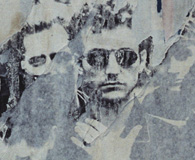 |
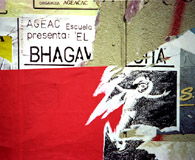 |
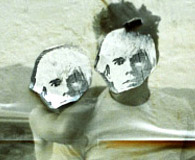 |
Before we discuss specific municipal legislation and the language used to distinguish between sanctioned and unsanctioned activities, I’d like to speak briefly to the origins of this research to provide a context for the direction our research has taken. Since 1985, I have been documenting examples of urban postering and graffiti, at first for their political commentary, but increasingly for their improvised aesthetics. The artistic nature of this photographic documentation really came into focus for me during a trip to England, Portugal, Spain and France in 1990. The richer diversity of imagery—overlaying political and social messages with all the promotions of high and low culture—suggested how the walls of cities could be a canvas for an on-going collective improvisation ruled by chance, happenstance, and the vagaries of weather, material substrate, and urban culture. My search for distressed affiches and unique examples of graffiti and stencil art took me into the most culturally diverse areas of the cities I visited—the contact zones of cultural formation. My guiding spirits were Walter Benjamin, Victor Turner and Hakim Bey.
Subsequent travels to San Francisco in 1991, New York in 1994, Europe again in 1995 and 1998, and visits to a number of Canadian cities—Vancouver, Victoria, Edmonton, Winnipeg, Toronto, Ottawa, Montreal—all provided opportunities to continue the project that I called Urban Wallpaper for a one-person exhibition at the Nanaimo Art Gallery in 1997.
As a study in improvised aesthetics, Urban Wallpaper is informed by an artistic tradition certainly as old as cave painting, petroglyphs and the graffiti found at Pompei. More recently, I trace its visual style from Cézanne’s interpenetrating planes (passages), through the cubism of Braque and Picasso, Dada collage and assemblage, the chance operations of Surrealism, Kurt Schwitters’ merzwerk, the appropriation of distressed affiches by the Nouveau Réalistes in France, and the strategies of the Situationists known as dérives and détournments. My research interest in the strategies of improvisation in the arts was illustrated in these spontaneous collective improvisations that seemed to add up to a polyvocal palimpsest of the zeitgeist—they were signs of the times that seemed to be worth documenting and, when carefully selected and framed, could be visually pleasing and provocative images. Ultimately, urban wallpaper is a form of signifyin(g), in the sense used by Louis Henry Gates in The Signifying Monkey: through repetition and revision, the images produce a critique of the cultural production we call society. Whether unmotivated pastiche or motivated parody, the layers of posters playfully signify in the mode of improvisation.
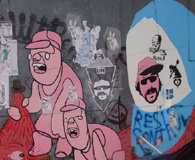 |
 |
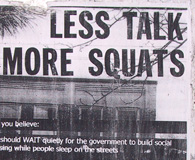 |
However, municipalities usually do not appreciate postering and graffiti for their aesthetics or documentation of social concerns; instead, our research into municipal legislation reveals some recurring themes. Postering is treated as a kind of visual pollution that can be distracting, messy, and unsafe. Graffiti is often defined as a crime against property, thus a form of vandalism. In combination, postering and graffiti are often thought to signify—according to the “broken window” theory—a higher incidence of crime in a given area, and a loss of control on the part of municipal authorities and law enforcement agencies.
We have found that the distinction between sanctioned and unsanctioned images is useful to describe how municipalities distinguish between those signs and marks required for commerce and good government from those which signify a lack of orderliness and loss of control. Alternatively, Joe Hermer and Alan Hunt distinguish between “official” and “unofficial” graffiti in an effort to pry open the complex discourse promulgated by “absent authorities” through a proliferation of signage—especially the prohibition circle with its diagonal red slash. “It is this world of everyday regulation,” they write, “which we seek to characterize as permeated with ‘official graffiti,’ which consists of a great profusion of regulatory signs, notices, symbols, and instructions that figure in everyday life” (457). Through a process they call “legal imperialism,” Hermer and Hunt argue that “the appearance of official status...is the key to a persistent blurring of the public-private divide” (456). At a fundamental level, the discourse between official and unofficial signs marks a contestation of urban space, its ownership, and control.
This view is brought into stark relief by Daniel D’Amico in his libertarian reading of the distinction between public and private property; he concludes, rather bluntly, that “graffiti ceases to be vandalism when it is displayed on public or abandoned property rather than private.” He justifies this conclusion by arguing that “the term graffiti can only be associated with paintings placed on government owned property, while vandalism refers to the defacement of private property and would be appropriately illegal and illegitimate in a Libertarian state….[G]raffiti should not be illegal in a Libertarian society because it is not a violation of private property rights, but rather it is akin to a liberation of stolen property from a coercive government.” This is clearly not an interpretation embedded in any of the municipal legislation we have encountered to date, but it might suggest motivation and justification for those who write graffiti or paste posters onto urban structures. D’Amico argues, in fact, that most graffiti is indeed found not on private property, but on public buildings and structures.
The dialectic between sanctioned and unsanctioned images in the public sphere
is a complex one, and the purpose of our research is to cleave a path between
the poles of opinion. As one of my guides in navigating this dialectic, I have
turned to the work of James Clifford. In Routes: Travel and Translation in the
Late Twentieth Century, Clifford begins with the notion that human location
is “constituted by displacement as much as by stasis” (2). His tools
for “prying open culture are expanded concepts of writing and collage,
the former seen as interactive, open-ended, and processual, the latter as a
way of making space for heterogeneity, for historical and political, not simply
aesthetic, juxtapositions” (3). Clifford explores how stasis and mobility
interact in the construction of (cultural) identity:
In the twentieth century, cultures and identity reckon with both local and transnational
powers to an unprecedented degree. Indeed, the currency of culture and identity
as performative acts can be traced to their articulation of homelands, safe
places where the traffic across borders can be controlled. Such acts of control,
maintaining coherent insides and outsides, are always tactical. Cultural action,
the making and remaking of identities, takes place in the contact zones, along
the political and transgressive intercultural frontiers of nations, peoples,
locales. Stasis and purity are asserted—creatively and violently—against
historical forces of movement and contamination. (7)
For Clifford, location is “an itinerary rather than a bounded site—a
series of encounters and translations” (11). If we think of our urban
centers as “contact zones” where “stasis and purity”—what
is sanctioned—are asserted against forces of “movement and contamination,”
we can identify some of the forces at work in the question of regulating images
in the public sphere.
First of all, the obvious ethical privileging of “purity” over “contamination” is a questionable distinction: is a large sign for the Chase Manhattan Bank “pure,” while a skillfully wrought graffiti piece a contamination? While municipal legislation takes great pains to encode the ethics of this distinction, Stallybrass and White in “Bourgeois Hysteria and the Carnivalesque,” suggest by analogy how repressed fear of disorder—as represented by the carnivalesque—can lead to suppression of energies and alternate politics that are required to invigorate democracies.
A further complication in this dialectic is the question of who owns the public sphere: those who are static or those who are mobile? As Jürgen Habermas argued in The Structural Transformation of the Public Sphere (1962), equal access to the public sphere, free from the threat of coercion is essential to the healthy functioning of democracy. If those with money and influence can erect signs in the public sphere, what provisions are made to provide equal access for all citizens? As we’re all aware, this issue is central to all questions of media access to the commons.
For municipal legislators and law enforcement agencies, however, the aesthetics of graffiti and postering are of lower priority because they feel compelled to respond to pressures from the public and business community to keep cities clean, orderly, and free of crime. They focus on the immediate realities of discharging their responsibilities in a legal and fiscally responsible way. In many cases we have seen, municipalities recognize the artistic merits of graffiti and the rights of citizens to expression, and attempt to find accommodations acceptable to tax-payers.
Although cities have found these visual markings on the urban landscape to be problematic, we want to keep open the possibility that these unsanctioned signs are an expression of culture worth noting and documenting, and suggestive of a troubling cultural divide. If municipal authorities misread these signs and their motivations, might their attempts to control them exacerbate the perceived problem? Deeper analysis of these related phenomena is our goal: to discover what these expressions might be telling us about urban culture and economics--not just with the single image or collage, but also the resistance to sanctions against them.
Tricia Irish will now summarize the more specific findings of our research on the language and strategies of municipal legislation. While our focus to date has been mainly to look at Canadian cities, we know that our concerns are shared by jurisdictions around the world, including the United States. Following Tricia’s analysis, we’ll explore some recommendations and open up the presentation to your questions.
References
Clifford, James. Routes: Travel and Translation in the Late Twentieth Century. Cambridge, MA: Harvard University Press, 1997.
D’Amico, Daniel. “Thou Shall Not Paint: A Libertarian Understanding of the Problems Associated with Graffiti on Public v. Private Property.” Law and Economics . March 26, 2003
Gates, Louis Henry Jr. The Signifying Monkey: A Theory of African-American Literary Criticism. New York: Oxford University Press, 1988.
Hermer, Joe and Alan Hunt. “Official Graffiti of the Everyday.” Law and Society Review. 30.3 (1996): 455-480.
Stallybrass, Peter, and Allon White. “Bourgeois Hysteria and the Carnivalesque.”
In The Cultural Studies Reader. 2nd Edition. Ed. Simon During. London: Routledge,
1993: 382-388.